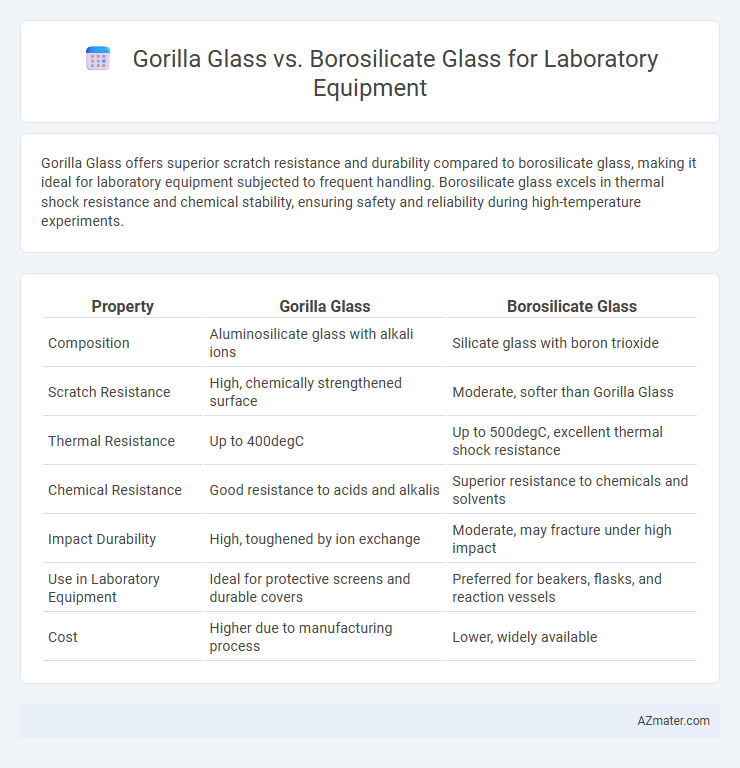Gorilla Glass offers superior scratch resistance and durability compared to borosilicate glass, making it ideal for laboratory equipment subjected to frequent handling. Borosilicate glass excels in thermal shock resistance and chemical stability, ensuring safety and reliability during high-temperature experiments.
Table of Comparison
| Property | Gorilla Glass | Borosilicate Glass |
|---|---|---|
| Composition | Aluminosilicate glass with alkali ions | Silicate glass with boron trioxide |
| Scratch Resistance | High, chemically strengthened surface | Moderate, softer than Gorilla Glass |
| Thermal Resistance | Up to 400degC | Up to 500degC, excellent thermal shock resistance |
| Chemical Resistance | Good resistance to acids and alkalis | Superior resistance to chemicals and solvents |
| Impact Durability | High, toughened by ion exchange | Moderate, may fracture under high impact |
| Use in Laboratory Equipment | Ideal for protective screens and durable covers | Preferred for beakers, flasks, and reaction vessels |
| Cost | Higher due to manufacturing process | Lower, widely available |
Introduction: Gorilla Glass vs Borosilicate Glass in Laboratories
Gorilla Glass offers exceptional scratch resistance and high impact durability, making it suitable for lab equipment exposed to frequent handling and potential drops. Borosilicate glass is renowned for its excellent thermal resistance and chemical inertness, which ensures stability during high-temperature experiments and exposure to corrosive substances. Choosing between Gorilla Glass and Borosilicate glass depends on balancing durability against thermal and chemical performance requirements in laboratory environments.
Material Composition and Manufacturing Processes
Gorilla Glass, primarily composed of alkali-aluminosilicate, undergoes a chemical tempering process involving ion exchange to enhance its strength and scratch resistance, making it highly durable for laboratory equipment. Borosilicate glass contains silica and boron trioxide, produced through controlled melting and annealing techniques that grant it excellent thermal shock resistance and chemical durability essential for lab environments. The distinct material compositions and manufacturing processes of Gorilla Glass and Borosilicate glass result in different performance characteristics, with Gorilla Glass excelling in mechanical durability and Borosilicate glass offering superior thermal and chemical stability.
Mechanical Strength and Durability
Gorilla Glass offers superior mechanical strength with high resistance to scratches, impacts, and bending, making it highly durable for laboratory equipment subjected to frequent handling and mechanical stress. Borosilicate glass, known for its excellent thermal resistance and chemical durability, is more brittle and prone to cracking under mechanical impact despite its ability to withstand extreme temperature changes. For laboratory applications demanding robust mechanical performance and sustained durability, Gorilla Glass provides enhanced protection against physical damage, whereas borosilicate glass excels in thermal and chemical stability.
Chemical Resistance and Reactivity
Gorilla Glass offers high scratch resistance but lower chemical resistance compared to Borosilicate glass, making the latter the preferred choice for laboratory equipment exposed to harsh chemicals. Borosilicate glass demonstrates exceptional chemical inertness and minimal reactivity with acids, bases, and solvents, ensuring sample purity and durability under rigorous laboratory conditions. Its superior thermal and chemical stability makes Borosilicate glass ideal for reliably handling corrosive reagents and extreme temperature changes in scientific experiments.
Thermal Stability and Heat Resistance
Gorilla Glass exhibits high thermal stability with resistance to sudden temperature changes, making it suitable for laboratory equipment exposed to variable heat conditions. Borosilicate glass outperforms Gorilla Glass in heat resistance, maintaining structural integrity at temperatures up to 450degC, ideal for experiments involving high heat or thermal shock. The choice between Gorilla Glass and Borosilicate glass depends on the laboratory's temperature range requirements and the need for durability against thermal expansion.
Optical Clarity and Light Transmission
Gorilla Glass offers superior optical clarity with high light transmission rates typically above 90%, making it ideal for precise visual observations in laboratory settings. Borosilicate glass, while chemically resistant and durable, exhibits slightly lower light transmission due to its thicker and more crystalline structure, which can cause minimal light scattering. For applications demanding maximum optical performance, Gorilla Glass provides enhanced clarity and reduced distortion compared to borosilicate glass.
Scratch and Impact Resistance
Gorilla Glass offers superior scratch resistance compared to borosilicate glass, making it ideal for laboratory equipment subject to frequent handling and abrasive contact. Its chemically strengthened surface provides enhanced impact resistance, significantly reducing the risk of breakage during accidental drops or mechanical shocks. Borosilicate glass, while resistant to thermal shock, generally falls short in durability against scratches and impacts in comparison to Gorilla Glass.
Cost and Availability for Lab Applications
Gorilla Glass offers a competitive cost advantage over borosilicate glass, making it an affordable option for laboratory equipment with high durability needs. Borosilicate glass, while typically more expensive, boasts superior thermal and chemical resistance, which justifies its widespread availability in specialized lab applications. The availability of Gorilla Glass is increasing due to its use in consumer electronics, but borosilicate glass remains more accessible for standard laboratory equipment suppliers.
Use Cases: Suitability for Different Laboratory Equipment
Gorilla glass offers high scratch resistance and durability, making it ideal for touchscreen devices and portable laboratory instrumentation that require frequent handling and impact resistance. Borosilicate glass excels in thermal resistance and chemical durability, which suits labware like beakers, flasks, and condensers exposed to high temperatures and aggressive chemicals. Choosing between Gorilla glass and borosilicate glass depends on the laboratory equipment's primary function, with Gorilla glass favored for protective surfaces and borosilicate glass preferred for heat- and chemical-resistant applications.
Conclusion: Choosing the Best Glass for Laboratory Needs
Gorilla Glass offers superior scratch resistance and durability, making it ideal for laboratory equipment subjected to frequent handling and impact stress. Borosilicate glass excels in thermal resistance and chemical stability, essential for experiments involving high temperatures and corrosive substances. Selecting the best glass depends on the specific laboratory application, balancing durability requirements with thermal and chemical resilience.

Infographic: Gorilla glass vs Borosilicate glass for Laboratory equipment
 azmater.com
azmater.com